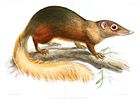| Planetetherium Temporal range: Latest Paleocene | |
|---|---|
| Scientific classification | |
| Domain: | Eukaryota |
| Kingdom: | Animalia |
| Phylum: | Chordata |
| Class: | Mammalia |
| Order: | Dermoptera |
| Family: | † Plagiomenidae |
| Genus: | † Planetetherium Simpson, 1928 |
| Species: | †P. mirabile |
| Binomial name | |
| †Planetetherium mirabile Simpson, 1928 | |
Planetetherium is an extinct genus of herbivorous gliding mammal endemic to North America during the Paleogene living from 56.8 to 55.4 mya, existing for approximately 1.4 million years. [1]
Fossils have been discovered in strata formed from ancient cypress forests, suggesting that this was the animal's preferred habitat.




